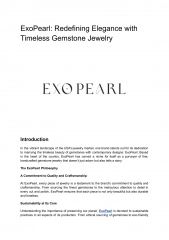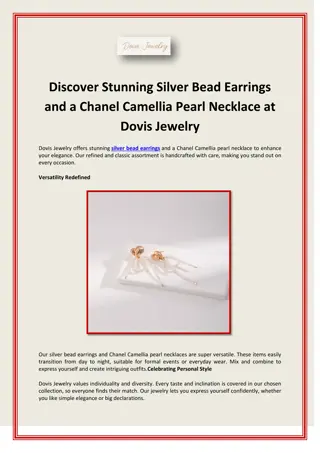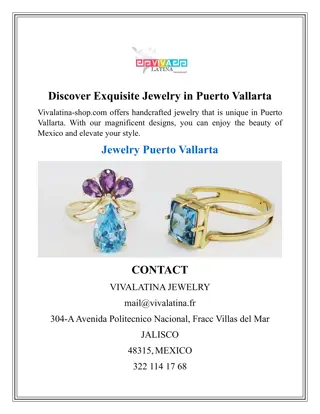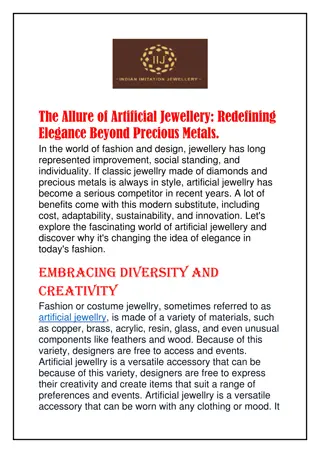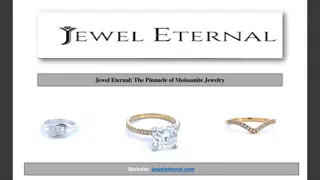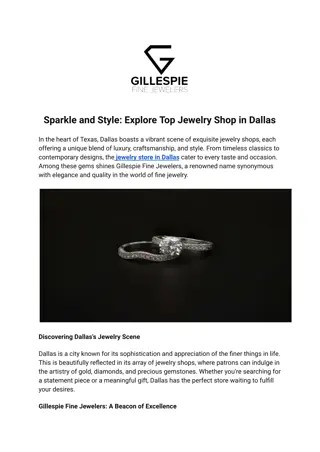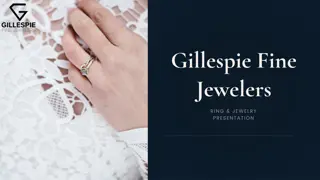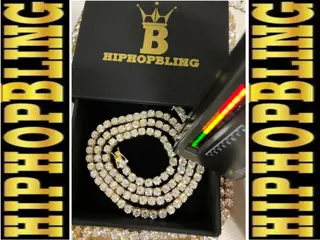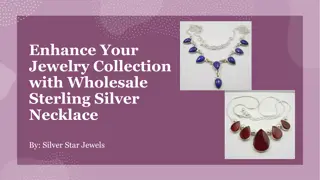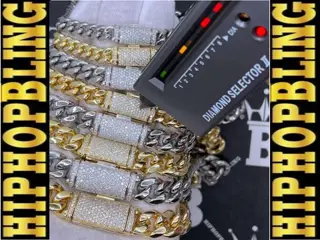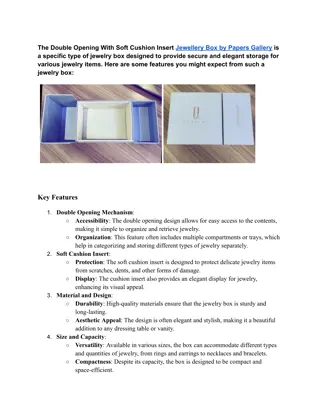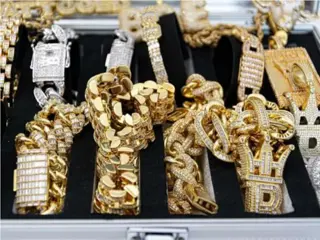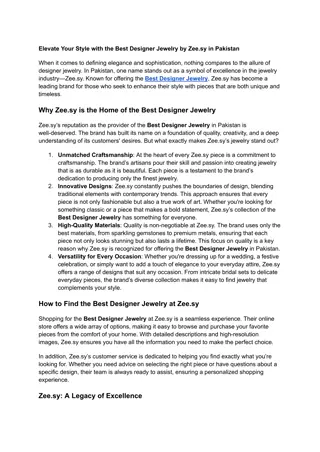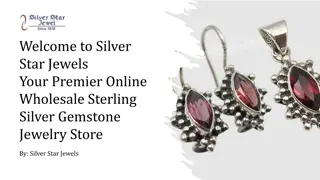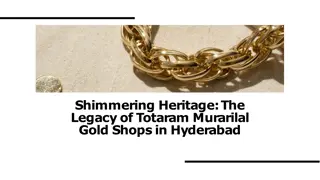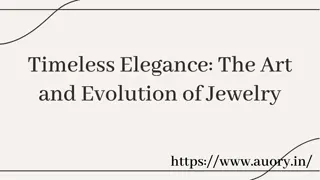
Challenges and Trends in the Jewelry Market
"The jewelry market has faced fluctuations due to the pandemic, changing consumer behaviors, and market trends. Sales have seen ups and downs, with different segments affected in varied ways. Inflation, cautious consumer spending, and shifting preferences towards lab-grown diamonds have all impacted the industry. Wedding market trends have also influenced jewelry purchases. Despite challenges, there are opportunities for retailers to adapt and thrive in this evolving landscape."
Download Presentation

Please find below an Image/Link to download the presentation.
The content on the website is provided AS IS for your information and personal use only. It may not be sold, licensed, or shared on other websites without obtaining consent from the author. If you encounter any issues during the download, it is possible that the publisher has removed the file from their server.
You are allowed to download the files provided on this website for personal or commercial use, subject to the condition that they are used lawfully. All files are the property of their respective owners.
The content on the website is provided AS IS for your information and personal use only. It may not be sold, licensed, or shared on other websites without obtaining consent from the author.
E N D
Presentation Transcript
The Chaos Continues The jewelry market has had a turbulent four years. First, the pandemic decreased US jewelry sales by 55.9% YOY during April 2020 but increased 211.7% YOY during April 2021 and decreased 7.1% YOY during April 2023, according to the US Department of Commerce. Weddings were postponed or cancelled and then rescheduled but the total still lags the post-pandemic period. Inflation has limited most of the jewelry purchases to the affluent but the jewelry market needs lower- to middle- income consumers for sustained growth. Data from the US Department of Commerce shows January was the only month of the first four of 2023 when jewelry sales increased at a modest +0.8% YOY but sales then decreased 6.5% during February, 8.8% during March and 7.1% during April.
Retail Insights Despite the current inflationary pressures on consumers, an industry analyst stated during May that independent jewelry stores sales decreased only 3% during Q1 2023. While sales increased at smaller and large retailers, they decreased at midsize jewelry retailers. Other industry experts are concerned that independent jewelers will have difficulty securing loans during the remainder of 2023. They conclude the pandemic caused many independents to focus on client connections and staging more in-store events. The Jewelers Board of Trade reported 18% fewer North American jewelry businesses closed during the first half of 2022 with retailers accounting for 271 of the total of 323 businesses. Conversely, there were 21% fewer new jewelry businesses during the same period.
Commodities Markets Trends When consumers are buying less fine jewelry, the commodities markets reflect that condition. According to Rapaport s RapNet Diamond Index, July 2023 diamond prices decreased substantially, with half- carats decreasing 4.8% and one-carats 2.7%. Synthetic or lab-grown diamonds were a major factor in diamond price decreases. Lab-grown diamonds share of the market has increased from 8.3% during 2022 to 17.3% during 2022 to 22.9% during February 2023. Gold prices for jewelry have fared better, increasing 3% YOY during Q2 2023, although, at the consumer level, much of the increase is attributable to more demand in the Chinese and Turkish markets.
Cautious Consumers Compound Challenges Inflation may have decreased and the job market may still be stable but consumers are cautious about spending. According to Numerator s Consumer Sentiment Study (as of 7/19/23), 70% of all shoppers were uncomfortable splurging on premium or luxury items. Provoke Insights Retail Consumer Trends Summer 2023 report stated 50% of surveyed consumers said they can easily cut purchasing fine jewelry and watches, first among 11 retail industries and 14% more than the average for all industries of 36%. The survey for the Provoke Insights report found just 18% of consumers said they would buy fine jewelry and watches at the same rate, placing the category 9th on the list of 11 industries and 5% less than the average for all industries of 23%.
Limited Weddings, Limited Jewelry Purchases The wedding market has suffered since 2020 when the total weddings decreased 16.6% from 2019, increased 12.4% during 2021 and increased 28.2% during 2022 as many postponed weddings occurred as the pandemic waned, creating a boon for jewelry stores. According to The Wedding Report, total 2023 weddings will decrease 16.0% and are forecast to decrease another 0.09% during 2024 and only increase 0.04% during 2025, indicating only moderate purchases of engagement and wedding jewelry. Signet Jewelers expects engagement jewelry sales to remain moderate through its fiscal year 2024 and estimates sales in this sector will have to increase 25% by 2026 to match sales before the pandemic.
Catering to the Gen Z Audience Gen Z is the generation being married or likely to marry within a few years. Signet Jewelers is forecasting an increase in sales through 2027 as it expects more engagements, which account for approximately 50% of the company s annual sales. Gen Zers as well as Millennials have been significant buyers of secondhand, luxury watches. Research suggests more than half of them have increased their spending on luxury watches during the past two years. According to a 2023 International Council of Shopping Centers survey, 28% of Gen Zers shop in-store to see, touch and try products, which is critical when purchasing jewelry and watches. Ability to obtain products immediately was first at 30%.
Advertising Strategies Although there is always a market for jewelry at various price points, consumers are looking for special offers and discounts for all their purchases because of inflation. Jewelry stores ad messages should feature products with the most affordable prices. With inflation depressing jewelry sales, retailers can emphasize their cleaning and repair services to make existing jewelry look newer. This is also an opportunity to create a database of customers for future ad campaigns once inflation has been conquered. Local media reps can help jewelry stores to boost the reach of their ad messages with the many active co-op advertising plans for fine jewelry and watches in Media Group Online s Co-op Advertising Directory.
New Media Strategies Although it will be 2025 before the number of weddings starts to increase YOY, jewelry retailers should commit some portion of their social media postings as regular messages, preferably short videos, about wedding jewelry to build a future customer base. With direct mail still a strong ad medium, especially among Millennials, jewelry stores may benefit from a holiday direct mail campaign that includes a QR code on the printed piece that connects consumers with special offers on social media or jewelers Websites. Because of inflation, many Gen Zers and Millennials are buying secondhand luxury watches. This is an excellent category for social media posts, showing the quality of secondhand watches, explaining how to find a good secondhand watch and the potential savings.

